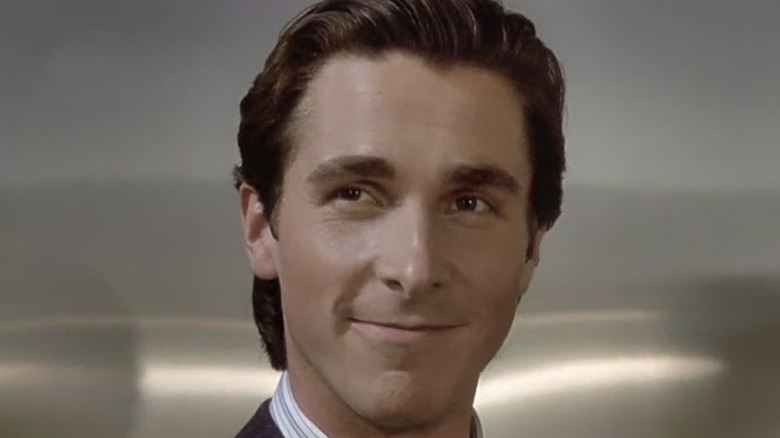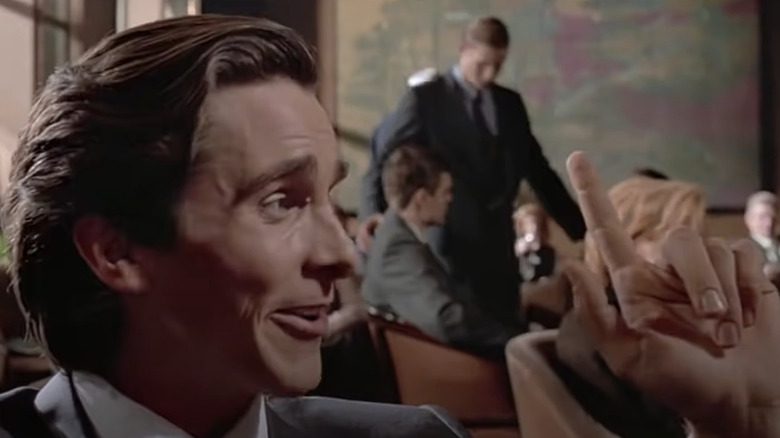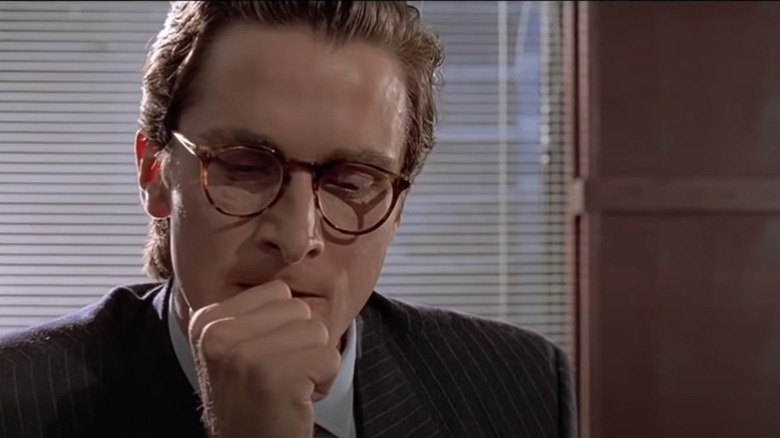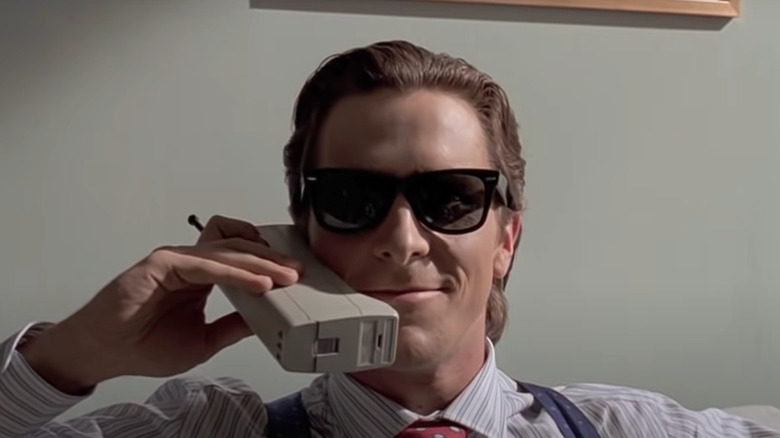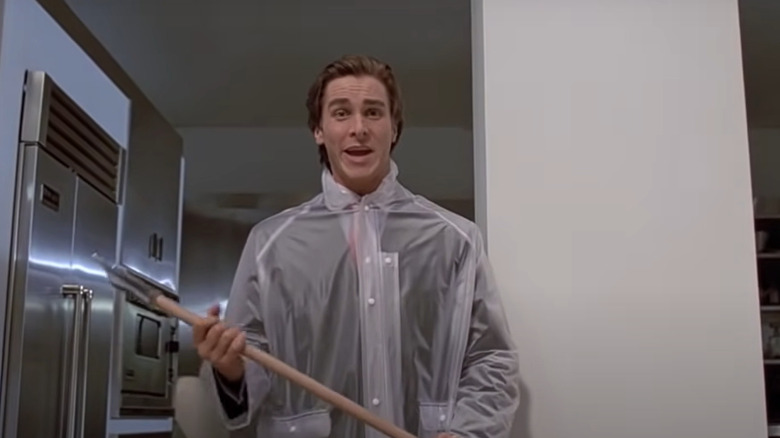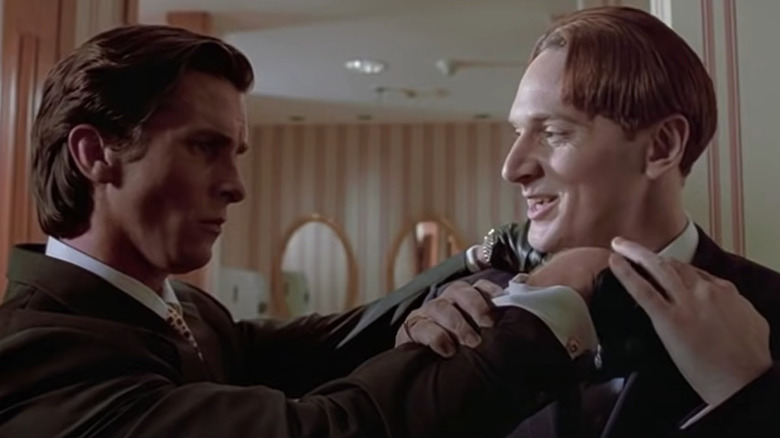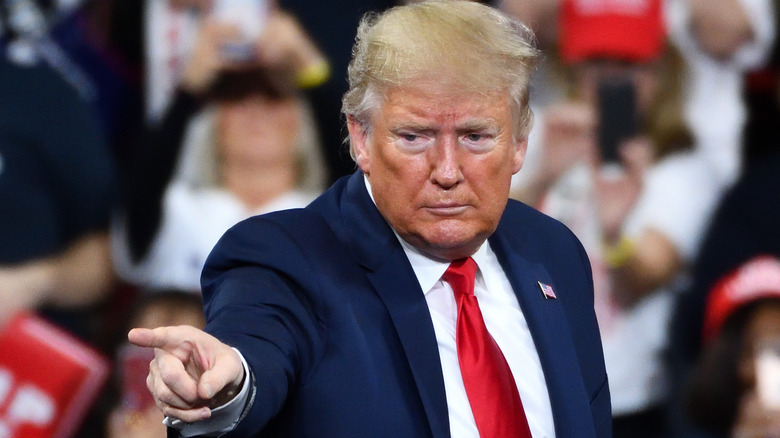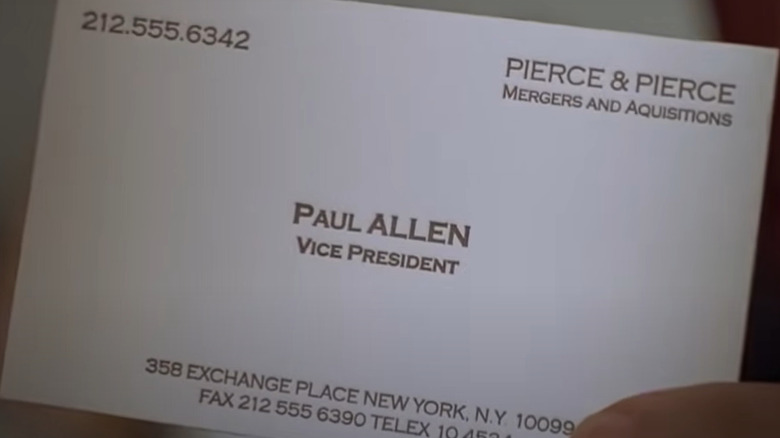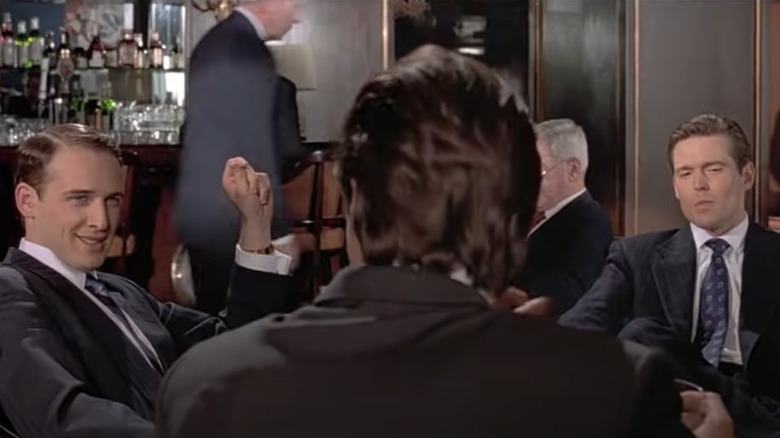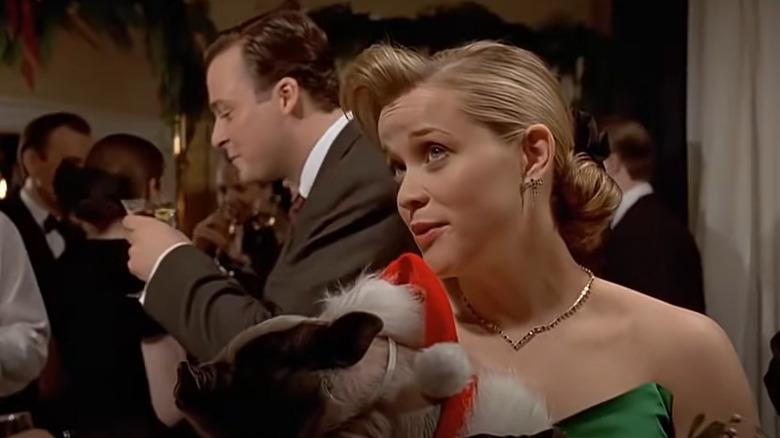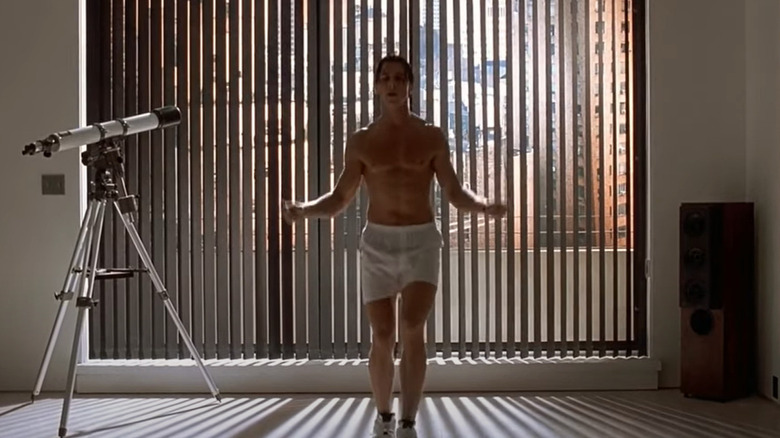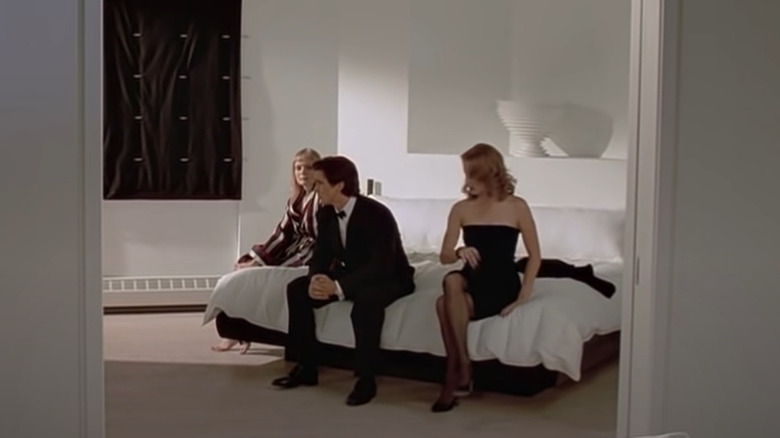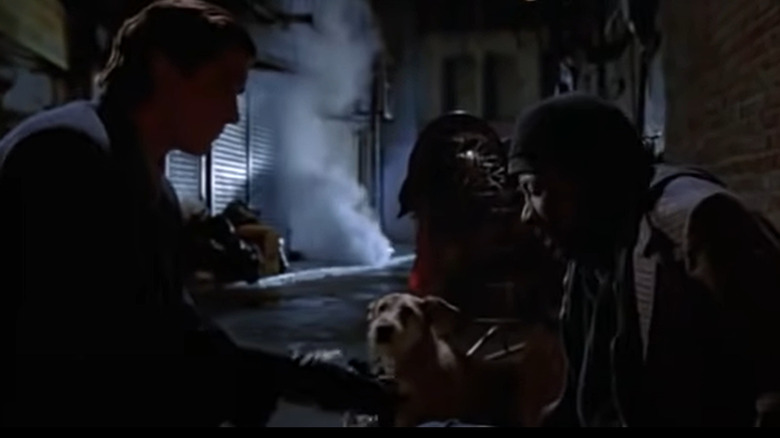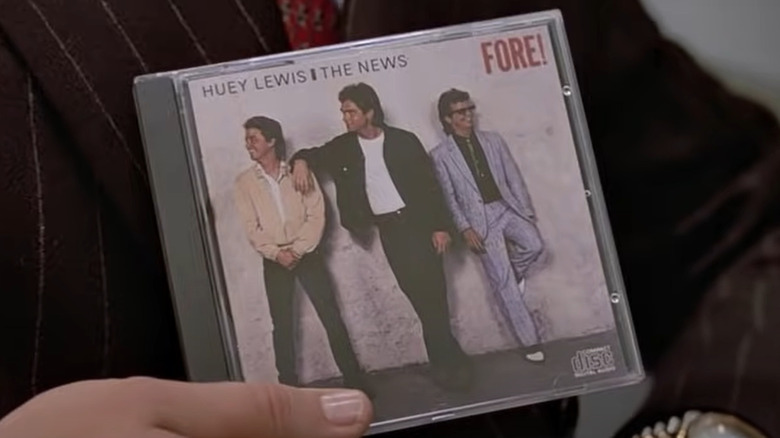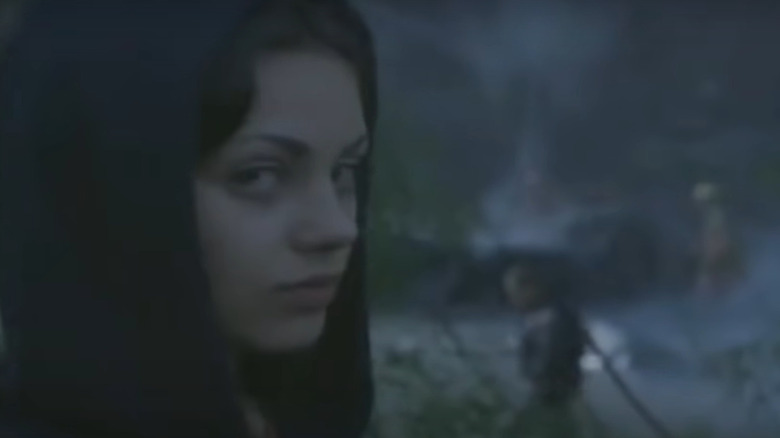The Best And Worst Things From American Psycho
Years before Mary Harron filmed a frame of "American Psycho," the Bret East Ellis novel occupied the same desolate neighborhood as Alan Moore's "Watchmen," John Kennedy Toole's "A Confederacy of Dunces," JRR Tolkien's "The Silmarillion" and others: brilliant, well-known and believed to be completely unfilmable.
Nevertheless, Harron took on what many considered a fool's errand, looking to make a cinematic version of a hugely-controversial book about a Wall Street yuppy with a grisly hobby that involved lots of blood, lots of plastic, and finishing it all up in time to return his rented VHS tapes before incurring a late fee.
Christian Bale was a similarly controversial casting as Patrick Bateman, a day trader whose taste is classy, his skin care routine is the length of the average Russian novel, and he takes his business cards deadly seriously. Also, he murders people.
But something funny happened on the way to the bargain bin. Harron's film, in the eyes of some, surpassed the novel. In the years since, it has only grown in stature — something ghat can't necessarily be said for the source material. The "American Psycho" film has garnered a reputation as a challenging look at male depravity. It also announced Bale's arrival as a serious actor, launched a thousand memes, and once again put Huey Lewis and the News in the good graces of pop culture.
Before your mask of sanity slips, put on your sharpest suspenders, dive into the height of '80s excess, and read on the best and worst parts of "American Psycho."
Best: Bale's performance
Christian Bale, with a famously intense commitment to roles and ability to lead in heavy dramedies, thrillers, and superhero movies alike, consistently delivers raved about performances. "American Psycho," paired with the similarly yuppy-gone-wrong role he played the same year in "Shaft," marked the beginning of an adult renaissance after following some lean (but mostly employed) years following early '90s films like "Newsies" and "Swing Kids." Bateman, as it turned out, presented the perfect opportunity for Bale to flex his acting (and ridiculously toned) muscles.
Like Robert De Niro as Travis Bickle or Michael Rooker in "Henry, Portrait of a Serial Killer," Bale rose to the occasion of playing a despicable anti-hero. Throughout the film, Bale walks a high wire of polite conversation, moments of insanity, and dialogue so surreal it practically belongs on "SNL."
While the movie's disturbing graphic content led to contentious critical and public reception, Bale's performance was widely praised. Roger Ebert — the late godfather of film criticism — called Bale's performance "heroic" in his review. He specifically noted Bale's masterful ability to throw caution to the wind and jump "joyfully into despicability." Bale doesn't just go over the top as Bateman, he obliterates the bar. It's wonderfully gruesome to behold.
Worst: Bateman's public life
While Bale's central performance as Bateman is iconic, some of the finer details of Bateman's life are never particularly well colored in. For example, in a movie about a serial killer who hides in plain sight due to his privilege, the audience is never really shown the hiding. While some of this works to further the movie's satirical mission, some of it creates questions.
For example, within the logic of the movie it makes sense that Bateman is only capable of speaking in long-winded rants about politics and pop culture that are essentially Wall Street Journal blurb regurgitations; the novel was the same way. In other words, Bateman's a terrible hang. The movie does a great job of showing the audience that Bateman is a person devoid of substance — but his good looks, tailored suits, and access to restaurants give him appeal in a broken society.
However, for a movie so focused on the awful symptoms of the disease called American capitalism, it never really depicts Bateman gaining capital. While it could be argued that Bateman not doing anything tangible at work is part of the movie's point, it feels like a misstep. Bateman being great at his job and being a mass murderer feels like the missing nail in the film's satirical coffin. Plus, Bateman having to deal with clients sounds like a wildly entertaining scene.
Best: Meme-ability
Not all great movies last in the cultural consciousness forever. For example, when was the last time anyone mentioned 2000's highly rated, hit comedy "Chicken Run?" However, thanks to the internet, some movies, like "American Psycho," get entire second lives as memes. And what a life it has had.
It's hard to know exactly why some intellectual property will be spliced up and passed around in group chats and DMs as gifs and photos for all eternity, but "American Psycho" certainly has thrived. Maybe it's the movie's extreme tone or all the different ways Bale flexes his acting muscles to bring that tone to life. Whatever it is, it has given us countless classics.
From Bateman sweating over business cards to Bateman eyeing himself intensely in the mirror with his partner's legs over his shoulders, the many faces of Christian Bale will live on in the virtual world for all time. While the filmmakers couldn't have imagined all the ways the movie would spread across message boards, Facebook timelines, and Twitter feeds, it's a testament to the film's greatness that it continues to find new relevance more than 20 years after its release.
Worst: Controversial violence
"American Psycho" is famous despite not being an easy watch. In fact, part of its staying power comes from its displays of extreme violence — many of which still cause a stir in viewers. But some of its graphic violence and satire blends better than other instances.
"American Psycho" is somewhat of a cautionary tale when it comes to blending bloodshed and thought provoking parody. While the majority of the movie's most explicit homicides are implied rather than explicitly displayed, the book's vile reputation created a cloud around most audiences going into the movie. In fact, according to a 1999 report, citizens of Toronto even protested the movie during its production. Later, director Marry Harron told the New York Times in an interview that a British tabloid called her movie "most disgusting film of the year" before it even came out. The movie had to contend with the MPAA and almost received the dreaded "NC-17" rating. And on top of all this, Harron said the movie was sued by a Florida man before he even saw it.
Believe it or not, the novel is even more graphic. One much-discussed scene involving a woman and a rat, for instance, were among those omitted.
With all this background noise upon the film's release, it isn't hard to see why some viewers may have initially assumed the gore was the point. While the film eventually went on to establish cult status as a savage look at '80s excess, lots of folks still think of it as the movie where Christian Bale drops a chainsaw on a lady of the night.
Best: Toning down the book's grosser moments
Even with all the hubbub around the violent content in "American Psycho," the movie is a master class in adapting difficult material. By all accounts, the Ellis novel was unabashedly, vividly disgusting. In fact, due to the novel's heinous descriptions of sex and violence, Bateman's ongoing inner monologue, and the extreme ambiguity of the book's ending, Ellis told Film School Rejects he still doesn't think his version of the story is adaptable.
While fans may never see a true take on the Ellis "Psycho" on the big screen, they did get a free lesson in how to square the focus of it. Director Harron's decision to elevate the book's humor and tone down the violence to exclude scenes like Bateman biting his ex-girlfriend's fingers off was a wise one.
Even though controversy around the book and the movie more than likely followed viewers into the theater during its initial release, Harron's emphasis on bleak humor helped "American Psycho" age like a fine wine. Today, many fans recognize the movie for the satire that it is. On its 20th anniversary, movie critic David Fear even called the film the "first great horror" of the 21st century in Rolling Stone.
Worst: Trump references
While some of the "American Psycho" jokes, meme-able moments, and album readings have aged like fine wine, others have grown sour. Former President Donald J. Trump may never appear in the movie proper, but Bateman reverently references the then real estate mogul multiple times in the film. In one scene, he even ignores his date in hopes of spotting a glimpse of Trump's car.
Given the movie's overall message about violent men with too much money and not enough empathy, there's something almost oddly clairvoyant in Bateman's preoccupation with Trump. Plus, some of Bateman's actions play like some of Trump's most outrageous campaign claims, including the ability to shoot someone in the street and get away with it. The whole thing is pretty chilling in hindsight.
Nevertheless, it is appropriate in a period-specific sense. To live and play in New York in the '80s was to see and hear the "Trump" name constantly, as it was the primary stage for his efforts to create a brand, and it makes sense that Patrick would idolize the perceived successes of the real estate magnate. While Bateman and the former president are by no means one to one stand-ins for each other, the link between the two men is an inspired decision for the absolute worst reasons. Bale even told MovieMaker during an oral history for the film that he felt Bateman would absolutely run for president if given the opportunity (via GQ). Yikes.
Best: Tackling consumerist excess with satire
Other parts of "American Psycho" have aged fantastically, like its no holds barred approach to taking down American excess in the 1980s. From Patrick Bateman's morning routine that plays more like religious label reading than self care to Bateman's obsession with the restaurant du jour, Harron makes everything but Bateman's murders seem deadly serious.
Even more specifically, consider the now endlessly-memed business card scene. Bateman and his co-worker Paul compare fonts, colors, and the artfulness of their business cards. Bateman decides Paul's is better and begins to sweat; the man can barely contain his rage. To vent, he leaves work and murders a homeless man. In short, Patrick's more bothered by the idea of a business card being superior to his than gunning down a human being in cold blood.
Satire, at its best, essentially bumps a situation up to eleven on the amp so the viewer registers the absurdity in the extra loud volume. When satire works, it cuts like a double edge sword because the joke is not only funny or bleak, but also makes a clear statement about its intended subject. "American Psycho" goes after commercial vanity by giving the audience a main character more concerned with a colleague's calling card than wanton violence. Dark, yes, but genius too.
Worst: Audience misunderstanding the satire
From "Fight Club" to "Every Breath You Take," sometimes the worst risk in making art that says something and wrapping it in an entertaining format is that some audiences embrace the entertainment value but miss the meaning. Martin Scorsese's "The Wolf of Wall Street" is another great example of this phenomenon — a movie about the perils of greed, so well crafted that it's remembered for its raucous party scenes.
While "American Psycho" didn't inspire any New Year's Eve parties (like 'The Wolf" did), it's not hard to see how the movie's violence largely overshadowed its satirical send up of consumerism. As entertaining as the movie's bleak sense of humor can be, it's hard to know if folks sharing clips of Bateman axing Allen remember the scene's poignancy, or just appreciate Bale being a nut job.
What's worse is that 20 years later, the 2000s satire about the 1980s seems more clairvoyant than ever. Or, in the words of movie critic Scott Tobias, "American Psycho hasn't left the culture, because the culture hasn't left American Psycho."
Best: Early career roles for great actors
While "American Psycho" will forever be a monument to the ongoing crusade of character work that is Christian Bale's acting career, the movie is a notable showcase of then up-and-coming talent. The cast includes: Reese Witherspoon, Jared Leto, Justin Theroux, Josh Lucas and Chloe Sevigny. While Witherspoon — who plays Bateman's fiancee Evelyn Williams — has gone on to have the biggest career of the stars listed above, Leto, Theroux, Lucas, and Sevigny have each worked some very memorable projects over the past two decades.
Leto, as Paul Allen, brings his impossible good looks to Bateman's rival; he then went on to play The Joker and star in "Dallas Buyers Club." Lucas and Theroux both play blank, smarmy members of Bateman's peer group; Lucas would go on to play young John Dutton on "Yellowstone," while Theroux starred in "The Leftovers" and wrote movies like "Tropic Thunder" and "Iron Man 2." Sevigny has appeared in a lot, but most notably she shows up in "Zodiac," arguably one of the best movies of the 21st Century.
"American Psycho" will forever be Bale's vehicle, but it's always a thrill to fire up a re-watch and see an entire generation of TV and movie talent in bloom.
Worst: Patrick Bateman lifestyle guides
Patrick Bateman's a terrible guy, but he's brought to life so well by Bale that some fans have mistaken his sociopathic nature for alluring charisma. While most people probably don't appreciate his penchant for unhinged murder, many viewers are interested in his lifestyle. For example, there's tons of articles breaking down Bateman's morning skin care routine — this one's even updated for 2022.
But it doesn't stop at skin care routines. There are virtual recreations of Bateman's apartment, and breakdowns of Bateman's wardrobes in magazines like GQ.
All of these pieces call attention to Bateman's worst impulses, overlooking the film's satire. Yes, both the film and novel depict Bateman's lotion, clothing, apartment, and food choices in granular detail. However, the interesting minutiae of Bateman's privileged existence shouldn't be the takeaway from a film where a man keeps human heads next to his sorbet.
So, even though the movie seems to imply skincare is not more important than murdering the unhoused, such interest in Bateman's material tastes would seem to indicate the point isn't always received loud and clear.
Best: It's a feminist film
In a 2014 interview with Dazed, screenwriter Guinevere Turner told the magazine she thinks it's very much a "feminist film." To her, it's obvious that in the world she and director Mary Harron put on screen the women are less important to their male counterparts than their workout routines and business cards.
This is another great example of the power of adaptation. Turner revealed when she was reading the book, some of the violence against women was so vile she thought to herself, "F*** you Bret Easton Ellis." But by honing in on the book's comedy and attention to male self-importance, Guinevere and company were able to remove a lot of the novel's vulgarity and create a damaging portrait of powerful men run amok.
Plus, audiences have caught up with the film's intentions. Turner also revealed to Dazed that other women in her life have told her for years that they didn't want to watch "American Psycho." She explains that many felt it was just another gore-nographic slasher film. However, she does add that more people have come around and recognized the movie's feminist underpinnings since its release.
Worst: Assaulting (mostly) marginalized folks on screen
Bateman being terrible is baked into the "American Psycho" central thesis about vapid violence at the heart of a culture that only cares about who is sitting where for dinner at Dorsia. The movie's commitment to its central idea means a lot of underprivileged folks wind up under Bateman's knife. It's par for the course in a film like "American Pyscho," but any audience member who feels it's excessive, too close to home, or just not for them has every right to feel that way.
While director Harron makes an effort to ensure most of Bateman's victim die just off screen, the suggested violence is still harrowing. The history of satire is chock full of creators going for the jugular — Jonathan Swift's famous treatise suggesting his British oppressors feed the starving Irish their own young is a great example — but it always runs the risk of becoming overwhelming for its audiences. Especially for any members experiencing similar trauma first hand.
To the film's credit, it makes its already extreme source material more palatable for most audiences. However, anybody who wants to skip a viewing to avoid scene after scene of women, minorities, and sex workers being brutally murdered by a smiling trust funder should go right ahead and do so.
Best: Shouting out Huey Lewis and the News
One of the most iconic moments in the "American Psycho" movie comes early in the film. Just before Bateman murders Leto's Paul Allen he launches into a diatribe about one of his favorite current bands, "Huey Lewis and The News." He discusses the band's early work, how they've changed over the years, and how they "came into their own, commercially and artistically," with the release of "Sports" in 1983. Then, Bateman starts playing the band's single, "Hip to Be Square" and buries an axe in Paul Allen's face.
It's shocking, funny, and bizarre. It also fits very neatly into the film's ongoing satirical bent. Bateman needs to keep Paul distracted, but can't have an actual conversation with a human being. Since Bateman doesn't know how to talk about anything meaningful, he begins reciting what sounds like a memorized music review.
All of this, paired with the fact that Bateman's song of choice is "about the pleasures of conformity" before bringing an axe down on a co-worker, makes the irony at work in the scene strong enough to make the Coen Brothers blush. It's one of those rare movie moments both hard to forget and a joy to dissect.
Worst: American Psycho 2
"American Psycho" gave movie fans brilliant performances, bizarro moments of violence, and enough satire to send dorm room philosophers into heated debates for the rest of eternity. However, it also gave movie fans the straight-to-video dud "American Psycho II: All American Girl." While the movie has some merits — including an early lead opportunity for Mila Kunis — the end result is definitely something that would wind up rolled in the newspaper on Bateman's living room floor.
The sequel follows Mila Kunis' Rachael Newman, a criminology student with dreams of joining the FBI. Her competitive program leads her to murder her fellow peers (yes, seriously) and the movie suggests this was sparked when Newman witnessed Bateman kill her babysitter as a child. While "American Psycho" on a college campus should've been a slam dunk, somewhere along the line, the executives dropped the ball and it bounced itself into a trash can. The satire of the original is gone, the plot makes little to no sense, and there's no ambiguity about whether or not Newman is committing the murders.
"When I did the second one, I didn't know it would be 'American Psycho II'," Kunis said in a 2005 interview, condemning a post production sleight-of-hand that had been done on a script she shot called "The Girl Who Wouldn't Die," subsequently re-titled and retro-fitted with the Bateman angle. "It was supposed to be a different project, and it was re-edited, but, ooh ... I don't know. Bad."
"Lions Gate wanted to put a serial killer in [the Ellis adaptation] 'Rules of Attraction' but [filmmaker Roger] Avary said no, and that's when they decided to make 'American Psycho 2'," added Bret Easton Ellis. "I've even heard that they were thinking about doing American Psycho in L.A., American Psycho in Las Vegas and making a whole franchise out of it ... if they're not careful they could end up with something like the 'Pink Panther' movies."
Critics have called the sequel a "sloppy mess" and it currently holds a whopping 0% on the Tomatometer. While "American Psycho" was one of the best reviewed movies of the early 2000s, its brilliance couldn't be repeated. Lucky for fans everywhere, Kunis emerged from this "American Psycho" slaughter unscathed.
